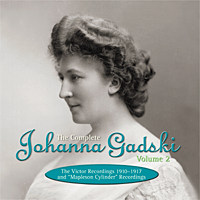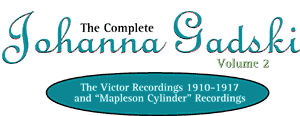
|
The Complete Johanna Gadski Volume 2Johanna Gadski (1872-1932) made almost 100 records for the Victor Company during her years with the Metropolitan Opera beginning in November, 1903. She established herself as one of the greatest Wagnerian sopranos of her time, yet Gadski was as adept at singing Verdi, Rossini and Mozart as she was at singing Wagner. What remained constant was that Gadski was a dramatic and monumental singer, whose remarkable technical security enabled her to go deeply into a role and explore every nuance. This 3 CD set marks the second and final volume of her complete recordings including the Mapleson Cylinders, the first complete recording of Wagner's "Wesendonck Lieder," and many selections never before heard on LP or CD. |
|
|

Johanna Gadski was one of the first important singers to record for the Victor Talking Machine Company. Beginning in 1903, Johanna Gadski recorded prolifically until her sudden departure from America in 1917. The repertoire which she recorded accurately mirrored the roles she sang at the Metropolitan and her ninety-three recorded sides offer a vivid demonstration of her tremendous versatility.
This three-disc set is the second and final volume of Johanna Gadski's complete recordings. It contains all of her Victor discs from 1910 to 1917. Also included here are the sixteen "Mapleson cylinders" on which Gadski can be heard. These cylinders, lasting only about two minutes each, were recorded above the stage during actual performances at the Metropolitan Opera House. Although the sound is remote, these recordings offer fleeting sonic snapshots which are always fascinating and often spellbinding.
By the year 1910, the Victor Talking Machine Company had achieved undisputed preeminence in the recording industry in America and its roster of important musical artists was most impressive. During this time, the company was constantly striving to improve its recording techniques to produce ever more brilliant sounding records. Therefore, in order to take full advantage of these innovations, Victor began to encourage many of its high profile artists to re-record their most popular titles. These new recordings were substituted for the old ones using the same catalogue numbers. For some unknown reason however, the company rarely advertised these replacements. Between 1910 and 1917, Johanna Gadski recorded a second version of five previously recorded items and in two cases even third versions were published. In preparing this edition, I have been fortunate in locating all of these alternate recordings.
Although Victor records from the 'teens do possess a heightened degree of brilliance, they are to my mind inferior to their earlier discs. They are often afflicted with a strange metallic stridency and a lack of focus that make them extremely frustrating to remaster. This harshness of tone is especially evident in the two Ballo arias and the 1915 recording of Wagner's "Liebestod." I have attempted throughout this set to emphasize the warmth in Gadski's voice and diminish as much as possible the sonic unpleasantness inherent in some of the recordings.
Before closing, I should mention that the recordings presented in this volume appear in date chronology with the following exceptions: I have placed the four sides from Aida together, as well as the three sides from Il Trovatore. Similarly, I have grouped Wagner's Wesendonk Lieder in score order. I have also presented both parts of Weber's "Ozean" aria together, although they were recorded a little more than year apart. Incidentally, there is a four bar lacuna between sides one and two, and therefore, I have left a slight pause where the sides join.